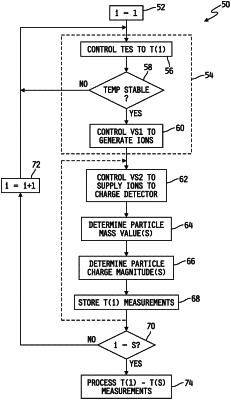| CPC H01J 49/165 (2013.01) [H01J 49/0031 (2013.01); H01J 49/0468 (2013.01); H01J 49/26 (2013.01)] | 20 Claims |

|
1. An instrument for analyzing charged particles, comprising:
an ion generator configured to generate charged particles from a sample of particles,
a mass spectrometer configured to receive the charged particles generated by the ion generator and to measure masses and charge magnitudes of the generated charged particles,
a thermal energy source configured to transfer thermal energy to at least one of the sample particles and the charged particles generated by the ion generator,
a processor, and
a memory having instructions stored therein executable by the processor to cause the processor to (a) control the thermal energy source to cause the charged particles to enter the mass spectrometer at each of a plurality of different temperatures within a range of temperatures over which the sample particles undergo structural changes, (b) control the mass spectrometer to measure at least the charge magnitudes of the generated charged particles at each of the plurality of different temperatures, (c) determine an average charge magnitude of the generated charged particles at each of the plurality of different temperatures based on the measured charge magnitudes, and (d) determine an average charge magnitude profile over the range of temperatures based on the determined average charge magnitudes.
|